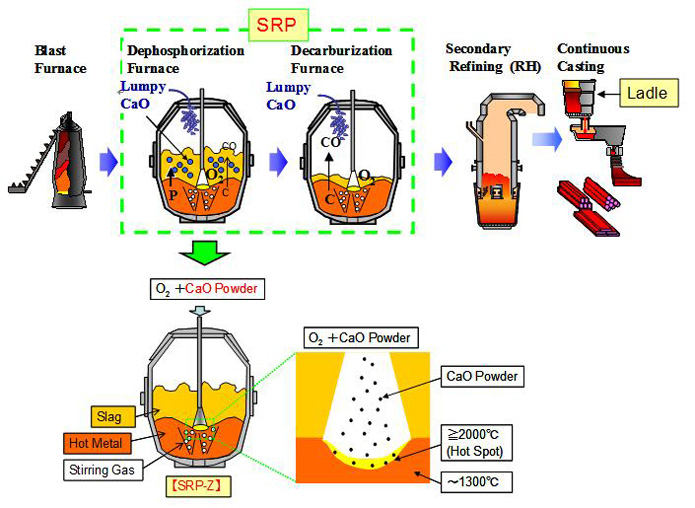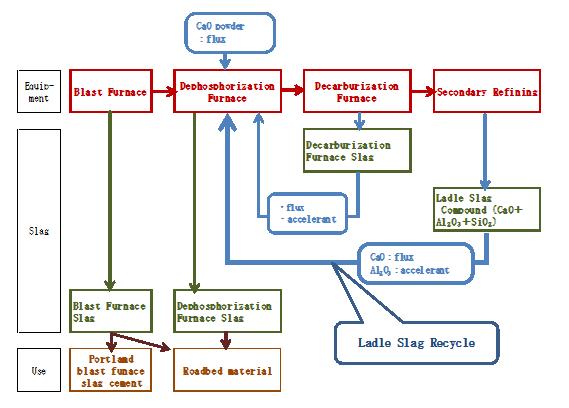Sumitomo Metals Realizes High Efficiency Production of Low Phosphor Steel with Low Environmental Load
- Development of New Molten Pig Iron Dephosphorization Technology
with Powder Top Blowing -
2010.10.20
- Sumitomo Metal Industries, Ltd.
Phosphorous contained in steel is a harmful impure substance that affects negatively to steel function in general. It affects the steel to lower hardness, degrade toughness, and weaken resistance to corrosion. Removal of phosphorous at low cost with minimal environmental load is an important issue in steelmaking. Sumitomo Metal Industries, Ltd. (Sumitomo Metals) has developed an innovative process, named SRP-Z (see graph 1), to blow dephosphorizing material in a powdered form on the surface of molten pig iron and has succeeded in applying this technology in industrial use for the first time in the world.
SRP-Z is a technology to raise dephosphorization reaction efficiency dramatically. It improves the quality of high-grade steel, enhances production efficiency, and lowers environmental load.
This technology is also an advanced development of SRP (Simple Refining Process) that Sumitomo Metals had developed. It received the Okochi Memorial Grand Production Prize (*1) in 2006.
1.Development background
The role of the refining process in steelmaking is to raise the purity of pig iron produced by a blast furnace with a high content of impurities. The most critical task is to remove phosphorous and carbon, which are impurities that make pig iron very brittle.
Thermodynamic requirements, such as temperature and basicity, are different in dephosphorization and decarburization. These two tasks have conventionally been carried out by a single steel converter but the SRP technology has assigned each task to be carried out by a different converter. Thanks to improved efficiency of using exclusive-use converters, benefits of the new process have far exceeded loss in time and energy in using two converters instead of one, in terms of work efficiency, energy efficiency, environmental load, and quality.
The flux used in a dephosphorization furnace is lumpy calcined lime (calcium oxide;CaO) conventionally. Calcined lime is low-priced but difficult to melt from a lumpy status due to its high melting point, over 2,000ºC. This has led to a problem in that some portion of calcined lime cannot melt and remains unreacted within the dephosphorization furnace. The conventional countermeasure has been to increase the amount of gas blown from the bottom of the furnace and stir the content inside. This, however, only results in limited improvement.
2.Outline of development
(1) Molten pig iron dephosphorization with powder top blowing (SRP-Z)
Sumitomo Metals has developed a process to blow calcined lime in a powdered form, from an oxygen top blowing lance (*2) on the surface of molten pig iron. The powdered form has a high surface area and thus a high reaction rate. The conventional process has used lumps because powder blows up within a converter and flows out of it without reacting with the iron. Sumitomo Metals has developed the oxygen top blowing lance specifically for powder top blowing and has improved operation so as to enable most calcined lime powder to react with the molten pig iron. As a result, the amount of calcined lime needed has been reduced by 15% and so has the time for dephosphorization.
In addition, the new technology has enabled use of slag that contains alumina AL2O3 ). Alumina has the property of promoting the dephosphorization reaction. The dephosphorization material that contains alumina has high stickiness and generates gas foam from reaction on the slag surface. As the foam sticks on the surface and bloats, the slag that contains alumina cannot be used with the conventional process. The new SRP-Z technology, however, can make foam pop off the surface by hitting it with the top-blown powdered,calcined lime. Therefore, the use of ladle slag (*3) that contains alumina contributes to even higher efficiency in dephosphorization.
(2) Effects
The new SRP-Z process has great secondary effects in addition to improvement in dephosphorization capacity.
Firstly,
CO2 for emission can be reduced because reduced amount of calcined lime decreases amount of energy needed for heating.
The second effect is reduction in iron dust, thanks to the oxygen top blowing lance that makes the reduced amount of calcined lime powder to blow up and improves operation. In addition, yield improves and so does the working environment.
The third effect is reduction in load by utilizing slag within a dephosphorization furnace. With the conventional process, slag has needed to be aged (*4) before being used as roadbed material. The unreacted calcined lime within slag has to be reacted with water to get bloated before it can be sold as roadbed material. The new SRP-Z process, however, rarely leaves unreacted calcined lime. Thus slag can be used as roadbed material with significantly less time for aging.
The fourth effect is that ladle slag can be internally used within the steelmaking process, resulting in no need to look for external recycling applications.
3. Future development
The new dephosphorization process has been adopted for converters at Sumitomo Metals’ Kashima Steel Works and Sumikin Iron & Steel Corporation in Wakayama and has contributed to production of high-grade steel for use in the energy industries. This process is also scheduled to be adopted at a new dephosphorization furnace due to begin operation this month at Sumitomo Metals (Kokura).
The Kashima Steel Works has already realized internal recycling of ladle slag for contributing to further reduction in environmental load. Sumikin Iron & Steel Corporation and Sumitomo Metals (Kokura) are also considering introduction of the similar recycling process.
Sumitomo Metals plans to adopt the new dephosphorization technology at all steel works of its Group and make progress in its initiatives to manufacture high-grade products efficiently with a minimal environmental load.
[Graph 1: Outline of Dephosphorization Technology with Powder Top Blowing (SRP-Z)]

[Graph 2: Kashima Steel Works’ Recycling and Application of Slag in Steelmaking]

<Terms>
*1)Okochi Memorial Grand Production Prize
| The Okochi Memorial Foundation presents the Okochi Memorial Prize for notable contributions in the areas of production engineering, production technology research and development, and the implementation of high-level production methods in Japan every year. |
*2) Top blowing the oxygen top blowing lance
| A top blowing lance is the tube that blows oxygen to the molten pig iron within a converter, from its top. A number of nozzles in complex form are attached to the tube and spray oxygen jet to the molten pig iron in the converter. |
*3)Ladle slag
Ladle slag is one kind of residual steel slag left after continuous casting. It contains alumina derived from aluminum which is added as a deoxidizing agent. |
*4)Aging
Aging is to make the unreacted calcined lime taken out of slag to be reacted with water, get expanded fully, and make stable. The aging methods include leaving it outside for a long time to be exposed to the weather; or to steam and stabilize it in a short time. |
